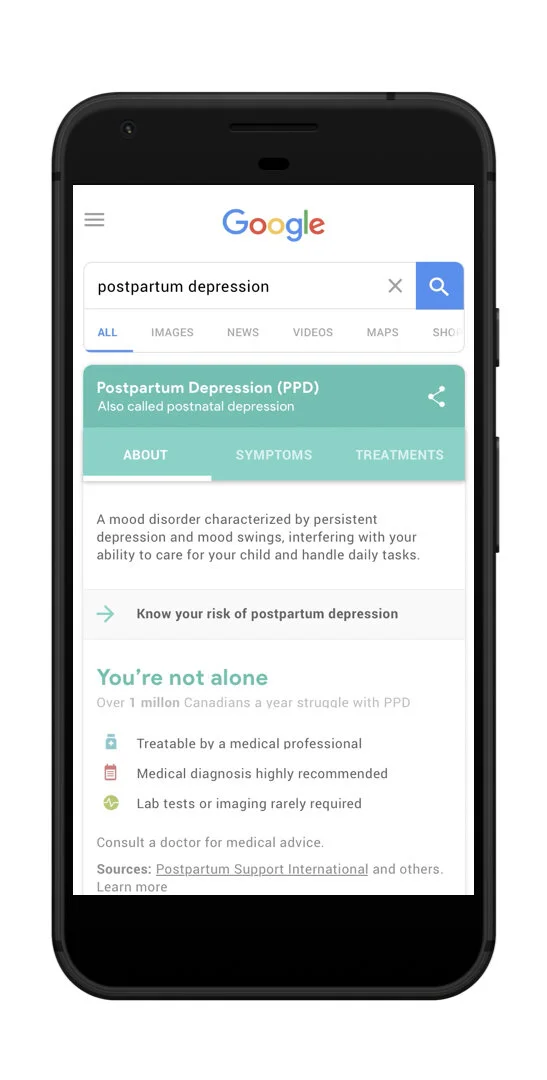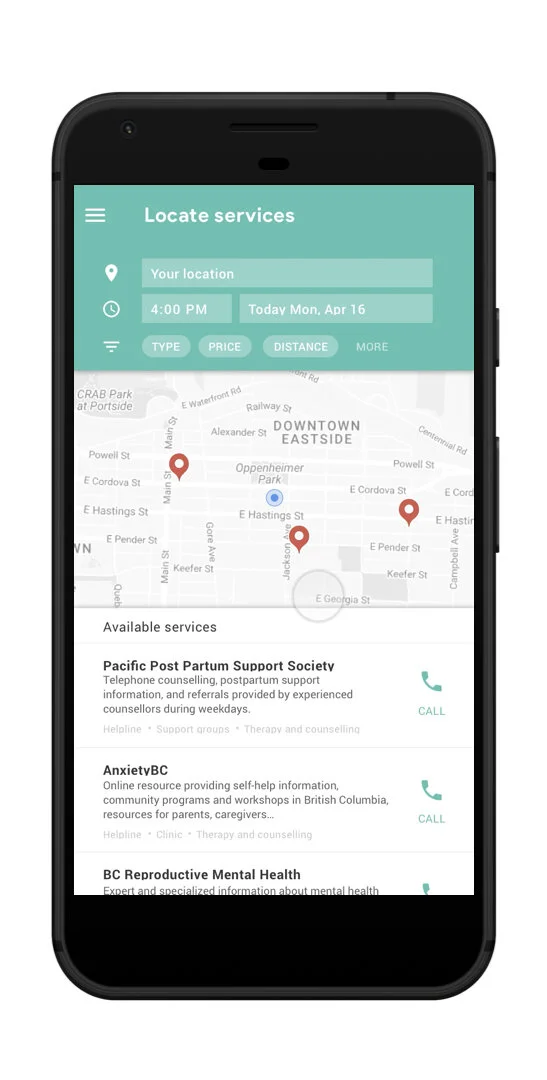
Improving mobile access to Postpartum Depression information and services.
Postpartum Depression (PPD) is a mood disorder that can begin during pregnancy or within the year following childbirth. The mood disorder affects 10-15% of all birthing persons, with the prevalence doubling for socioeconomically disadvantaged individuals living in urban areas. Inclusive Postpartum Care is a mobile platform that utilizes responsive Google web searches to facilitate access to information and services for new, urban, low-income parents who are (at risk of) experiencing Postpartum Depression.
Originally completed for a graduate-level design course at Simon Fraser University, Inclusive Postpartum Care was showcased to local design professionals and received high praise for its perceived impact.
Vancouver User Experience Awards
Winner of People’s Choice Award, 2018
Finalist for UX by Students Award, 2018
Project Type
User Research
Product Design
Interaction Design
Content Strategy
Year
2018
Team
Aron Chen
Gabriel Yeung
View
Keynote

Postpartum Depression (PPD)
Concerns around Postpartum Depression.
Left undiagnosed or untreated, PPD can develop into chronic or recurring depression amongst many long-term consequences. Despite this, the American Psychiatric Association reports that only 15% of those affected by PPD seek professional help, which includes, but is not limited to, receiving a diagnosis and/or treatment.
Low-income parents are at increased risk.
In a cross-sectional survey on urban parents’ socioeconomic status and their interactions with postpartum (post-birth) health services, BMC Health Services Research reports that “socioeconomically disadvantaged [parents] experience higher rates of postpartum depression… 22-30% compared to 13% overall prevalence in the general population.”
Although the term socioeconomically disadvantaged extends beyond income levels to encompass other factors contributing to one’s socioeconomic status, Inclusive Postpartum Care uses low-income to define the specific condition it aims to address.
Design Problem
Barriers to seeking and receiving help.
Insights gathered from academic studies and various social media platforms revealed that parents’ key barriers to seeking help are limited time, poor information accessibility, and difficulty finding relevant services. These barriers were later validated through online surveys and interviews with new parents and related professionals, including a family physician, social worker, and financial advisor.
Barriers to seeking information and resources.
In analyzing the accessibility of information and resources available on the web, three key barriers were identified: information overload, crowded or irrelevant results, and medical jargon that hinders one’s ability to understand information effectively.
How might we support new, urban, low-income parents in seeking professional help?
The goal of Inclusive Postpartum Care is to improve access to and comprehension of information regarding PPD in order to support new, urban, low-income parents who are (at risk of) experiencing PPD in engaging with professional help.
Process & Insights
Formative Research
Identifying information-seeking behaviours.
To address the challenge of integrating the design into the lives of new parents, a 2016 article by the Maternal and Child Health Journal (annotated Abstract shown below) outlined several practices of low-income parents when seeking postpartum health information; particularly, that smartphones are used to access the internet and websites in short bursts of only 10-15 minutes a day. These behaviours informed the core product features and key design decisions.

Primary Research
Understanding postpartum experiences and needs.
To understand parents’ individual postpartum experiences, challenges, and needs, I created an anonymous Google survey (below left) and conducted an informed consent interview with a parent in treatment for PPD. When discussing challenges, a pattern arose (below right); new parents needed reassurance that their experiences were normal. Oftentimes, this was achieved through consulting or confiding in other parents.
Questions from the Google Survey. [Screen capture]
Annotated responses from the Google Survey and transcribed interview. [Screen capture]
Product Features
Health Card
Streamlining the information-seeking experience.
To streamline information-seeking, the design surfaces relevant information and resources in the form of a Health Card. Organized into three key sections—About, Symptoms, and Treatment—the Health Card communicates medical health information through inclusive language and highlights important resources, such as the Edinburgh Postnatal Depression Scale (EPDS) screening tool.
The Health Card format was chosen after studying Google’s Knowledge Graph—a knowledge base that refines search results and removes the need to click through websites by pulling information directly from credible sources. This is particularly beneficial for individuals who have little time to do research.
Edinburgh Postnatal Depression Scale
Surfacing the most relevant and important resources.
According to the National Alliance on Mental Illness, mental health screening tools can help raise awareness and support seeking help earlier.
To facilitate engagement with professional help, the design includes an adapted version of the Edinburgh Postnatal Depression Scale (EPDS), a 10-item questionnaire widely used by health professionals to screen birthing persons for PPD. Each answer is associated with a numerical value which contributes to the EPDS score—an indicator of a parent’s likelihood or risk of experiencing PPD.
To further support parents in having informed conversations with healthcare providers about how they have been feeling, the adapted version of the EPDS introduces the ability for parents to add detailed notes for future discussions.
Service Locator
Filtering services for parents’ unique needs.
To address new parents’ difficulty in finding postpartum health services, the Service Locator offers various filters to facilitate the process. These filters include options for service type, operating hours and availability, cost (if applicable), distance away, as well as additional amenities, such as childcare or free parking.
Saving services for later.
Understanding that new parents are often busy and use technology in short bursts of only 10-15 minutes per day, the “Save” function allows parents to pick up wherever they left off and easily access services they were looking at.
Key Design Decisions
Content Strategy
Leveraging information-seeking behaviours.
The accessibility of information and services is improved by leveraging smartphones and default web browsers as a low-barrier entry-point for new parents who have limited time.
Creating Empathy and Trust Through Design
Recognizing the complexity of PPD, content is designed to be reassuring and relatable. Quotes communicate symptoms and feelings, encouraging vocabulary suggests actions, and plain terminology replaces medical jargon to promote understanding. Finally, the colour teal was selected—through user-testing—to ensure the design feels trustworthy and empathetic rather than clinical or over-optimistic.
Images humanize the mood disorder and teal is used to convey a trustworthy, empathetic tone.
Plain, inclusive language is used to facilitate understanding of medical information.
In-line quotes help describe symptoms and experiences in an emotional and relatable manner.
Reassuring and encouraging language is used to alleviate negative feelings and inspire action.
![Results of user testing various versions of the prototype with 16 random individuals. [Synthesized digital findings]](https://images.squarespace-cdn.com/content/v1/5f4ff754995c7c4c85720dae/1601937001539-RGF3N4WJBQ7NSMZ91JGG/PPD-ColourTest.png)
Results of user testing various versions of the prototype with 16 random individuals. [Synthesized digital findings]
Reflection
Designing for human needs.
Inclusive Postpartum Care aims to support new parents by acknowledging their unique experiences and providing help that is tailored to their needs. Regardless of socioeconomic status, Postpartum Depression is one of the most common complications of childbirth, yet often goes misdiagnosed or undiagnosed. There are many barriers a new parent may face when seeking help, including a poor model of healthcare, lack of support, fear of judgement, or simply being unaware of Postpartum Depression. The goal of this design was to improve access to and comprehension of Postpartum Depression information, but more importantly, to bring hope and empowerment to new parents so that they can take action and engage with the care that they need.
A people-first design solution.
When I defined Postpartum Depression as the problem to design for, I knew it would not be an easy task. It was, and still is, such a complex topic that is frequently frowned upon or not discussed. There were simply too many potential unintended consequences that could or would result from a lack of understanding; There were too many assumptions that could be made about the mood disorder and target population.
As one might begin venturing into unchartered territory, I began fact-finding through the internet. I soon learned that this would not be enough; I was limiting my own understanding and my vision of opportunity by only consulting websites, social media, and academic articles. This prompted a necessary transition to consulting the people most impacted—parents and families—and other primary stakeholders, such as healthcare providers. This made all the difference; everything became more real and more relevant to the problem and revealed opportunities for the design.

![Questions from the Google Survey. [Screen capture]](https://images.squarespace-cdn.com/content/v1/5f4ff754995c7c4c85720dae/1601749757452-RB5U1HS2LSH6ZMJZ1OZ2/PPD-PrimaryResearch-1.png)
![Annotated responses from the Google Survey and transcribed interview. [Screen capture]](https://images.squarespace-cdn.com/content/v1/5f4ff754995c7c4c85720dae/1601749757161-KJ8OM052X2O0FFD1RPDP/PPD-PrimaryResearch-2.png)





